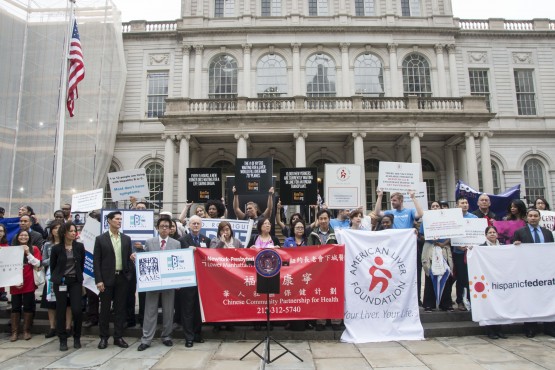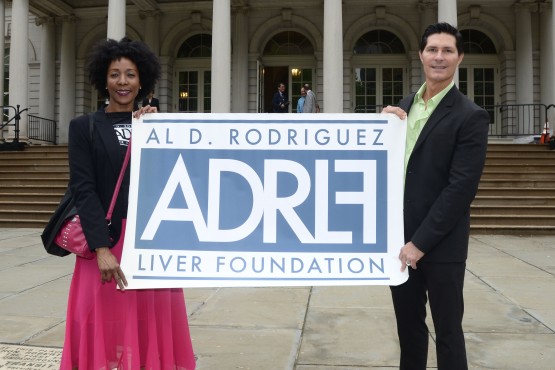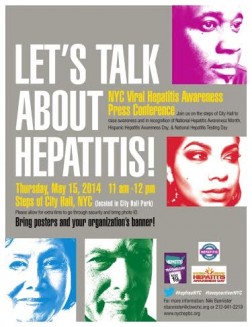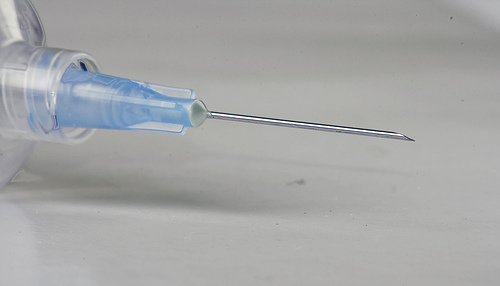New York, NY – May 15, 2014. Representatives from community-based organizations, local and federal public health officials, NYC Council members and patient advocates gathered on the steps of city hall today to raise awareness about viral hepatitis (hepatitis B and hepatitis C). This event coincides with May’s National Hepatitis Awareness Month, which includes National Hispanic Hepatitis Awareness Day (May 15th) and National Hepatitis Testing Day (May 19th).

Leaders and supporters gather at the NYC city hall to send strong messages of Hepatitis awareness.
NYC leaders call for action to address the impact of viral hepatitis and seek to: increase public awareness of and concern about hepatitis B and hepatitis C; to improve testing, care, and treatment; and prevent liver disease and cancer. This coincides with the recently updated national cross-agency Viral Hepatitis Action Plan released in April 2014.
Between 3.5 and 5.3 million Americans, and 250, 000 NYC residents are living with chronic (lifelong) viral hepatitis, and most of them do not know that they are infected.[1] Viral hepatitis is the leading cause of liver cancer and the most common reason for liver transplantation in the United States.[2] In addition, it is a leading infectious cause of death in the U.S., claiming the lives of 12,000–18,000 Americans each year.1 In the U.S., viral hepatitis disproportionately affects the African American, Hispanic and Asian American and Pacific Islander communities.
In a World Hepatitis Day Proclamation on July 26, 2013 President Barack Obama stated “Viral hepatitis is a silent epidemic, and we can only defeat it if we break that silence. Now is the time to learn the risk factors for hepatitis; talk to family, friends, and neighbors who may be at risk; and to speak with healthcare providers about strategies for staying health… [L]et each of us lend our support to those living with hepatitis and do our part to bring this epidemic to an end.” President Barack Obama, July 26, 2013.[3]
In recognition of National Hepatitis Awareness Month, NYC community-based organizations will be hosting screening events and educational workshops (nychepbc.org/hepatitis-awareness-press-conference-2014) in conjunction with other events taking place throughout the country (www.cdcnpin.org/HTD). Also, Asian Week Foundation and National Viral Hepatitis Roundtable coordinated a new public service announcement (PSA) to highlight National Hepatitis Testing Day in partnership with CBS HealthWatch and scheduled to be aired on CBS from May 17 to May 19 in New York City, Los Angeles, San Francisco, Chicago, and Seattle. The PSA features a call for hepatitis testing as a way to prevent liver cancer and includes a unique URL for each city (NYC is: http://ny.heptesting.org) that links to local hepatitis resources and screening events.
[General/Screening] Al D. Rodriguez Liver Foundation Board Member and Emmy Award-winner Carson Kressley said: “The loss of our dear friend Al — the namesake of the Al D. Rodriguez Liver Foundation — is a constant reminder that hepatitis and liver cancer can happen to anyone. This May 19, ADRLF encourages all New Yorkers to ‘Screen. Vaccinate. Don’t Hesitate.'”
“Hepatitis B disproportionately affects those that are foreign-born,” says Dr. Vivian Huang, physician and hepatitis B program director of the Charles B. Wang Community Health Center. “If you are a foreign-born New Yorker or have parents that are foreign-born, it is important that you get tested for hepatitis B. Hepatitis B is a virus that can damage your liver and lead to liver failure and/or liver cancer. The disease usually has no symptoms until it is too late. But there is good news, when detected early, it is an easily manageable condition and there are medications that can keep the disease under control.”
Lisa Gallipoli, Executive Director, American Liver Foundation – Greater New York Division stated “Hepatitis Awareness Month is truly about catalyzing ACTION against Hepatitis. With the increased availability of effective treatments for Hepatitis C, we need to ensure that at-risk individuals, especially baby boomers, are asking their doctors about getting tested, and that primary care physicians are testing their patients.”

ADRLF Board Members show their steadfast support for National Hepatitis Awareness Month and Hepatitis Testing Day on May 19.
“The American Cancer Society recognizes that the burden of cancer is unequal across ethnic groups, and the Society is committed to playing an active role in decreasing and contributing to the elimination of disparities. The Society continues to partner with NYC public health organizations to raise awareness about viral hepatitis B and viral hepatitis C as the most common risk factor for liver cancer” stated Natasha Coleman, Senior Director, State Health Systems of the Eastern Division of American Cancer Society.
[Hepatitis and the Hispanic community] In 2012, approximately 4,300 Hispanics will be diagnosed with liver cancer, and about 2,700 will die from the disease. Liver cancer incidence rates in the U.S. are about twice as high in Hispanics as in non-Hispanic whites.“We are deeply concerned about these incidence and death rates, and are partnering with an array of community leaders and advocates to ensure that Latinos/Hispanics are not left behind when trying to access care and treatment” stated Bethsy Morales-Reid, Hispanic Federation.
[Hepatitis and the African American community] “Hepatitis C is one of the most serious health disparities affecting black communities,” said C. Virginia Fields, president and CEO of the National Black Leadership Commission on AIDS, Inc. “African Americans are twice as likely to have been infected with the hepatitis C virus compared to the general U.S. population, and we make up roughly 22% of the estimated 3.2 million persons with chronic hepatitis C, which is a leading cause of potentially deadly liver disease. We must ensure that our communities are informed about the dangers of viral hepatitis and that they have access to testing and treatment that will safeguard their health and well-being.”
[Hepatitis and Persons Who Inject Drugs] People who inject drugs are at increased risk for hepatitis B and C An estimated 64% of PWID are chronically infected with hepatitis C and 2.7-11% are chronically infected with hepatitis B. Daniel Raymond, Policy Director at Harm Reduction Coalition stated “The Centers for Disease Control and Prevention reported a 45% increase in new infections between 2010 and 2011,” said Daniel Raymond, Policy Director for the Harm Reduction Coalition. “We need to come together to increase our prevention efforts, particularly for a new generation of opioid injectors at risk.”
[Hepatitis and the Asian American & Pacific Islander community] Dr. Warren Chin of the Chinese American Medical Society stated “One in twelve Asian Americans and Pacific Islanders (AAPIs) is living with chronic hepatitis B and as many as two out of three AAPIs with chronic hepatitis B are unaware of their status. Without appropriate medical treatment, one out of four will die of cirrhosis and liver cancer. Chronic hepatitis B and hepatocellular cancer is the single greatest health disparity between AAPIs and Caucasian Americans. We are encouraging not only community members at risk to get tested but also informing our physicians and healthcare providers to make an effort to test all their patients at risk.”
Soonsik Kim, Project Coordinator at Korean Community Services stated that “Liver cancer is the fourth most common cause of cancer among Korean Americans. This is mainly due to a high prevalence of hepatitis B infection in the Korean population. It is very important for Korean Americans to know that chronic hepatitis B is preventable and treatable. Koreans Americans can break the cycle of infection by getting tested and vaccinated!”
[1] U.S. Department of Health and Human Services. April 2014. Action Plan for the Prevention, Care, and Treatment of Viral Hepatitis – Updated 2014-2016. Retrieved from http://aids.gov/pdf/viral-hepatitis-action-plan.pdf on May 6, 2014.
[2] Centers for Disease Control and Prevention. Viral Hepatitis. Retrieved from http://www.cdc.gov/Hepatitis/ on May 6, 2014.










 MEDIA ADVISORY
MEDIA ADVISORY

























